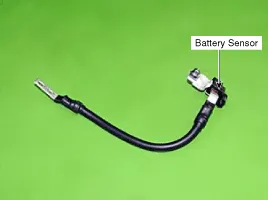Hyundai Genesis (DH): Charging System / Battery Sensor Description and Operation
| Description |

When battery sensor signal fault occurs, check whether the
parasitic draw is not abnormal (Refer to vehicle parasitic current
inspection) |
It takes a few hours for a new battery sensor to detect the battery state correctly.
Perform the following process after replacing the battery sensor.
|
For the vehicle equipped with a battery sensor, be careful
not to damage the battery sensor when the battery is replaced or
recharged.
Troubleshooting Removal 1. Disconnect the battery negative (-) cable. 2. Disconnect the battery sensor connector (A). 3. Remove the battery negative (-) cable after removing the bolts (B). Other information:Hyundai Genesis (DH) 2013-2016 Service Manual: Condenser Repair proceduresInspection 1. Check the condenser fins for clogging and damage. If they are clogged, clean them with water, and blow them with compressed air. If they are bent, gently bend them using a screwdriver or pliers. 2. Check the condenser connections for leakage, and repair or replace it, if required. Hyundai Genesis (DH) 2013-2016 Service Manual: Climate Control Air Filter Repair proceduresReplacement 1. Remove both stoppers (B) by turning them from the glove box (A). 2. Disconnect the air damper (A) from the glove box (B). 3. Remove the filter cover (A) by pressing the knob. 4. Replace the air filter (A) with a new one according to the direction of air filter. Categories
Copyright В© 2025 www.hgenesisdh.com - 0.0291
|


